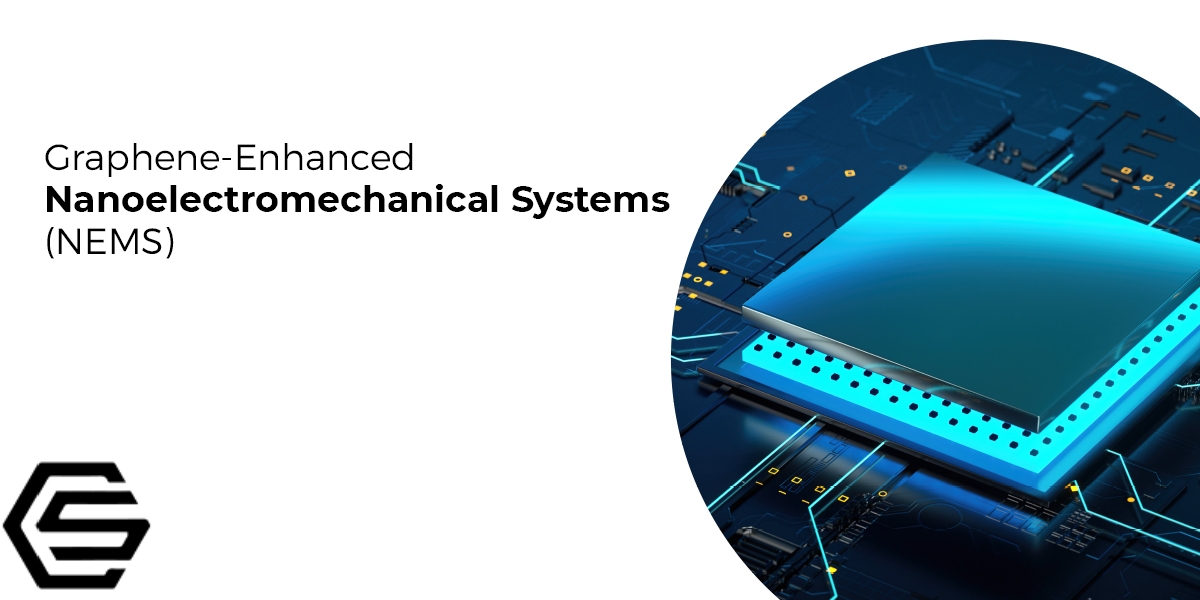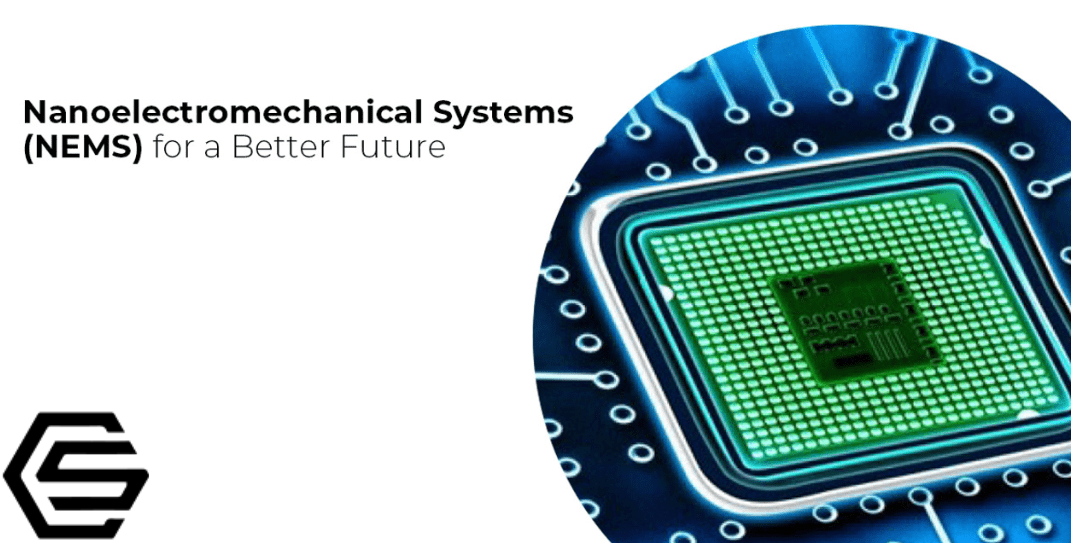What are Nano Electrochemical Systems (NEMS)?
Nano-electromechanical systems (NEMS) are miniature devices with critical components at the nanoscale, typically ranging from nanometers to micrometers in size. These devices combine mechanical elements, such as tiny beams, cantilevers, or resonators, with electronic or optical functionalities.
Components: NEMS devices feature various mechanical components, often fabricated from materials like silicon, carbon nanotubes, or graphene. These components can be actuated and sensed using electronic or optical means.
Actuation and Sensing: Precise control of mechanical motion or deformation at the nanoscale is a key feature of NEMS. Actuation methods include electrical, thermal, or optical forces, while sensing mechanisms detect and measure mechanical changes, often through electronic or optical readouts.
Graphene in Nanotechnology
Graphene is a two-dimensional material with exceptional properties such as high electrical conductivity, mechanical strength, and flexibility. It plays a crucial role in nanotechnology with applications spanning electronics, sensors, nanoelectromechanical systems (NEMS), energy storage, transparent conductive films, nanocomposites, biomedical fields, catalysis, nanoelectronics, and nanomaterial synthesis. Its versatility and unique properties make it a key enabler for numerous innovative technologies across diverse industries.
The Role of Graphene in Nanoelectromechanical Systems (NEMS)
Graphene has a strong connection with NEMS due to its exceptional mechanical and electrical properties, making it an ideal material for integrating into NEMS devices.
Sensing: Graphene can be used as a sensitive component in NEMS-based sensors. Its electrical conductivity can change in response to mechanical strain, making it suitable for detecting tiny mechanical movements or forces. For example, graphene NEMS sensors can be used for detecting gas molecules, pressure, or even biological molecules.
Actuation: NEMS devices often require precise actuation mechanisms. Graphene's mechanical strength and flexibility can be harnessed to create nanoscale actuators that respond to electrical signals, enabling precise control over the mechanical movement of NEMS components.
Resonators: NEMS resonators, which vibrate at high frequencies, benefit from the lightweight and high-stiffness properties of graphene. Graphene-based resonators can be used in applications such as frequency filters and signal processing.
Energy Harvesting: Graphene's electrical properties can be used to convert mechanical vibrations or movements into electrical energy in NEMS-based energy harvesting devices.
The exceptional properties of graphene make it a valuable material for incorporating into NEMS devices, enabling the development of highly sensitive sensors, precise actuators, resonators, and energy harvesting systems at the nanoscale. This intersection between graphene and NEMS holds great promise for advancing nanotechnology and various practical applications.
For more detailed information about Nanoelectromechanical Systems (NEMS), you can also read this blog post.
Advantages of Graphene in Nanoelectrochemical Systems (NEMS)
Nano-electromechanical systems (NEMS) offer several advantages over traditional micro-electromechanical systems (MEMS) and macro-scale devices, making them increasingly important in various applications. Some key advantages of NEMS include:
Miniaturization: NEMS devices are extremely small, with critical components at the nanoscale. This miniaturization allows for the development of ultra-compact and lightweight devices, making them suitable for applications where space and weight constraints are crucial.
High Performance: NEMS devices often exhibit superior performance compared to their micro- and macro-scale counterparts. Some advantages include higher resonance frequencies, greater sensitivity, and lower power consumption. For example, NEMS resonators can oscillate at much higher frequencies, enabling faster signal processing and communication.
High Sensitivity: Due to their small size, NEMS sensors can detect and respond to minute changes in their environment. This high sensitivity makes them ideal for applications such as chemical and biological sensing, where detecting trace amounts of substances is critical.
Energy Efficiency: NEMS devices can operate with significantly lower power consumption compared to larger systems. This energy efficiency is especially valuable in battery-powered or energy-constrained applications, where extended operational lifetimes are essential.
Improved Performance in Extreme Conditions: NEMS devices can operate in harsh environments, including high temperatures, high pressures, and corrosive atmospheres. Their robustness and resilience make them suitable for applications in aerospace, automotive, and oil and gas industries.
High Precision and Accuracy: The precise control and manipulation of nanoscale mechanical components in NEMS allow for high precision and accuracy in various applications, such as positioning and measurement.
Multifunctionality: NEMS devices can combine multiple functions into a single compact platform, simplifying device integration and reducing complexity. For example, a single NEMS-based sensor may simultaneously detect temperature, pressure, and chemical changes.
Fast Response Times: NEMS devices can respond rapidly to changes in their environment due to their small mass and high resonance frequencies. This fast response is advantageous in applications that require real-time monitoring and control.
Compatibility with Nanomaterials: NEMS can be integrated with other nanoscale materials, such as graphene, carbon nanotubes, and nanoparticles, to enhance their performance and enable new functionalities.
Potential for Quantum Technologies: NEMS devices are being explored for quantum applications, offering the potential for quantum sensing, quantum information processing, and quantum communication.
Low Cost of Materials: Some NEMS devices can be fabricated using cost-effective materials and manufacturing techniques, making them economically viable for various applications.
Overall, NEMS offer a range of advantages, including miniaturization, high performance, sensitivity, energy efficiency, and versatility, making them valuable in a wide spectrum of industries and emerging technologies. Their continued development and integration into various applications hold significant promise for future advancements.
Uses of Graphene-Based Nanoelectrochemical Systems (NEMS)
Nano-electromechanical systems (NEMS) find diverse applications due to their small size, high sensitivity, and versatility.NEMS' ability to operate at the nanoscale offers novel solutions in various fields, from healthcare to quantum computing, with ongoing research leading to further innovations. Some key applications of NEMS include:
Sensors: NEMS-based sensors are highly sensitive to mechanical, chemical, or biological changes in their environment. They are used in various applications, such as accelerometers for motion detection, gas sensors for environmental monitoring, and biological sensors for detecting biomolecules.
Signal Processing: NEMS-based resonators are utilized in signal processing, such as high-frequency oscillators and frequency filters for wireless communication and advanced signal manipulation.
Energy Harvesting: NEMS devices can convert mechanical vibrations or other forms of energy into electrical power, making them valuable for energy harvesting applications, such as powering wireless sensor networks.
Biomedical Devices: In the biomedical field, NEMS are employed in drug delivery systems, lab-on-a-chip devices for diagnostics, and for studying biological processes at the nanoscale.
Quantum Technologies: NEMS are being explored for quantum applications, including quantum sensors and quantum information processing, contributing to advancements in quantum technologies.
Communications: NEMS-based devices have the potential to enhance communication technologies through the development of high-frequency oscillators and resonators.
Challenges and Future Prospects of NEMS
The fabrication and manipulation of Nano-electromechanical Systems (NEMS) present significant challenges due to their incredibly small size and the requirement for meticulous control. Furthermore, tackling concerns such as energy dissipation and reliability becomes paramount when operating at the nanoscale.
Current research endeavors are dedicated to propelling NEMS technology forward, encompassing the exploration of novel materials, innovative fabrication methodologies, and diverse applications. The potential impact of NEMS across various industries is immense, holding the promise of catalyzing groundbreaking technological advancements in the near future.




















